Library Management System Project Report
The Library Management System Project Report Docs contains Abstract, Documentations, and Source Codes needed in developing its software configuration.
Additionally, it reveals the important diagrams that will build the Library Management System’s Structures and behavioral aspects.
These guidelines will serve as the basis in system designing and creating the project.
The project report presents the basic details of Library Management System from its abstract, up to its documentation and source codes. It also adds the blueprints and structure designs which were applied in developing the operating system.
It includes the Project compositions, abstract, modules, proposal and many more.
Each of the topic related to the Project Report for Library Management System were emphasized thoroughly.
It not only ensures the project development procedure but also secure that you understand them. First to discuss is the Development Composition.
Project Report for Library Management System: Development Composition
| Project Name: | Library Management System Project Report |
| Abstract: | The System greatly lowers manual effort and allows for a seamless flow of library activities by eliminating the possibility of errors when doing its activities. |
| Modules: | • Book Information Recording • Administrator Login • Users/Borrowers’ Login • Book Monitoring and Updates • View and Check Information • Borrowing Information • Borrowing Records |
| Documentation Diagrams (UML): | Class Diagram, Sequence Diagram, Use Case Diagram, Data Flow Diagram, ER Diagram, Activity Diagram |
| Programming Languages: | C#, PHP, Java, Django, JavaScript, C++, C, and Python, |
| Documentation Chapters: | Chapters 1-5 |
Library Management System Project Abstract
The abstract of Library Management System Project enlightens you on what should be put into consideration when creating the project.
It contains the ideas on how will the project work in terms of behaving with the users. It answers the needs of the users and giving appropriate outputs for the users.
The Library Management System Project Abstract shows the project’s overall description without going into great detail. It briefly explains the ideas and contents of Library Management System but in clear manner.
All in all, the abstract of Library Management System project explains about what is expected from the software.
Performing library management manually is quite difficult, as is maintaining its records in order.
These are the issues that the Library Management System should address and answer.
The Library Management System (LMS) is a program that helps librarians manage a library. Based on the needs of users, the system could provide a minimal set of functionality, such as adding and updating members and books.
This system can also handle check-in specifications, borrower’s transactions and more.
A library management system can automatically cater all of library information and transactions.
It aims to organize all of the activities involved in library management software. This can also provide information about the books in the library, their authors, library members, book borrowers, and library personnel.
Project Report for Library Management System Modules:
The Project Report for Library Management System Modules will give you the idea on what should be included in the project.
It has the complete discussion of Library Management System Modules.
- Book Information Recording: All the information of each books should be recorded into the system to provide the borrowers or the students the book references that they want to borrow.
- Administrator Login: The admin login will require the school librarian their email and password to have the main access to the system and secure every information ang transaction done in the system.
- Users/Borrowers’ Login: This will also require the users or students email and password provided when they were registered into the system. Their email and password will serve as their access to the system in terms of borrowing books or inquiring for books.
- Book Monitoring and Updates: The system should save the borrowers info and the count of books that are borrowed. These records should also be updatable when the books are returned.
- View and Check Information: The admin can view and check the books that are borrowed and who were the students that borrowed them. Students can also view their borrowing transactions just like the book information, date of book borrowing and returning.
- Borrowing Information: The borrowing information should consist the important details of the borrowers and the books borrowed by each borrowers. This information should also record the day of borrowing as well as the returning of the book.
- Borrowing Records: This will record all the transaction made and are stored for a period of time to serve as reference for important matters.
These modules must be present in creating the Library Management system Project to satisfy the needs in managing Library transactions.
Through this, the borrowing and returning of books would be much easier for both students and librarians.
Project Report for Library Management System UML Diagrams
Here are the essential Diagrams for the Library Management System Project Report and Thesis Documentation.
1. Library Management System ER Diagram
This college library management system database design was made based on managing library requirements. The system can encode students’ or borrowers’ information.
College admin can have access to the students’ status and information for borrowing transaction. They can handle the data needed in managing books files as well as the transactions made by their borrowers.
The features included in the system ER diagram were the security and monitoring of the book and borrowers’ records, transactions and status.
These features were also listed and recorded in reports that served as the history of transactions done in the system.
Sample ER Diagram for College Library Management System Project Report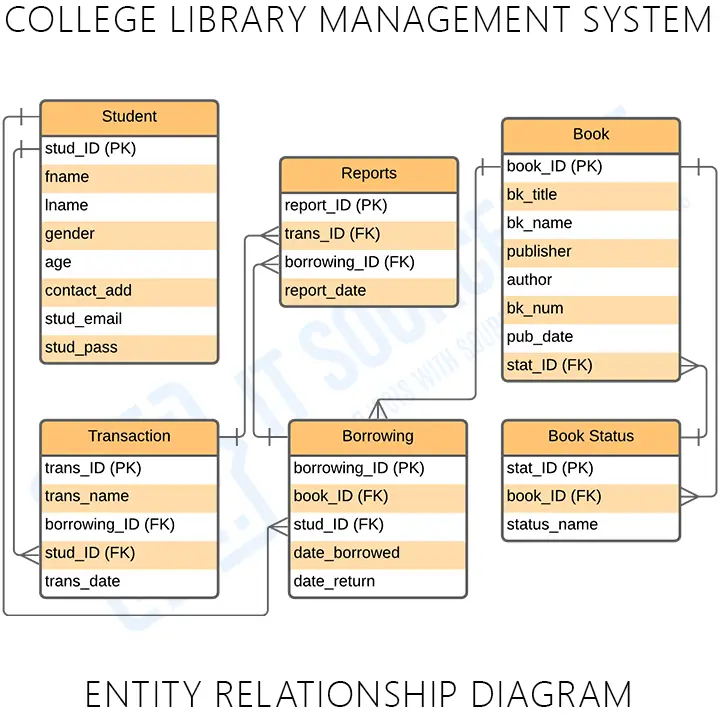
Click here to download the Library Management System PDF.
2. Library Management System Use Case Diagram UML
A use case diagram is a visual representation of how a user might interact with a program.
A use case diagram depicts the system’s numerous use cases and different sorts of users and is frequently supplemented by other diagrams.
Circles or ellipses are used to depict the use cases.
This discusses the meaning of the library management system project UML as well as its use case diagram using include and extend.
By creating the use case of the library management system, you must determine first the possible features to identify the flow of the system.
After that, you can now create the blueprint or core of the system function.
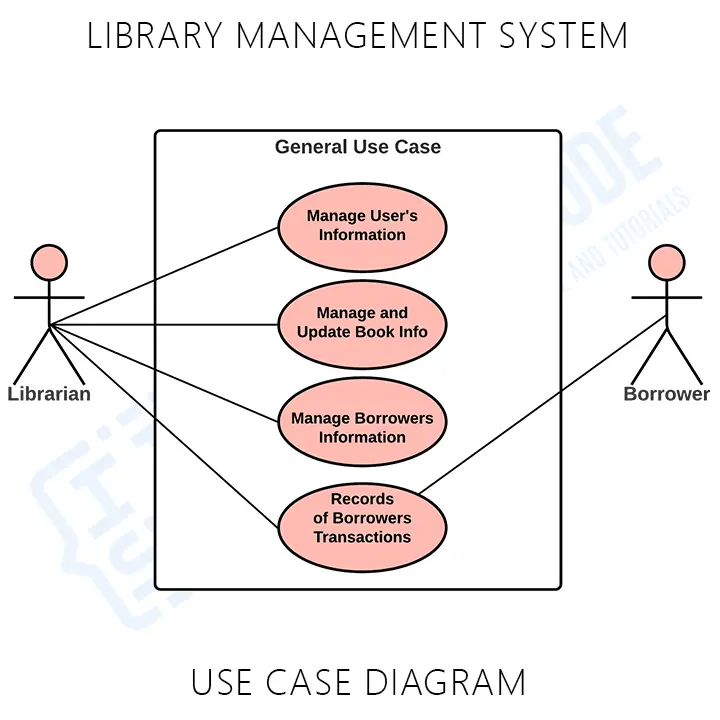
Click here to download the Library Management System PDF.
3. Library Management System DFD (Data Flow Diagram)
This knowledge will also give you deep understanding about Library management system DFD levels 0, 1 and 2.
I will teach you also the terms in managing the Library transactions as well as the flow of activities happens in library management system.
The Data Flow Diagram (DFD) represents the flow of data and the transformations in Library management system.
These transformations occurs as data enters and exits a system. In the DFD, input, processing, and output are used to represent and define the overall system.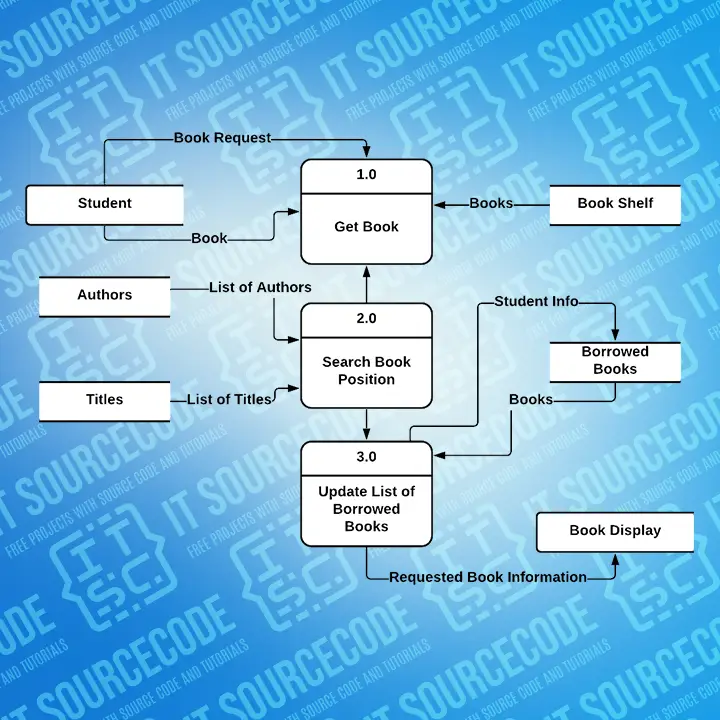
Click here to download the Library Management System Project PDF.
4. Library Management System Class Diagram
Library Management System Class Diagram is a designed diagram that shows the system’s relationships and classes.
This UML Class Diagram is made to guide programmers along with the library management system development.
It contains the class attributes, methods as well as the relationships between classes.
These mentioned contents makes sure that your Library management system development must inline with what should be its functions.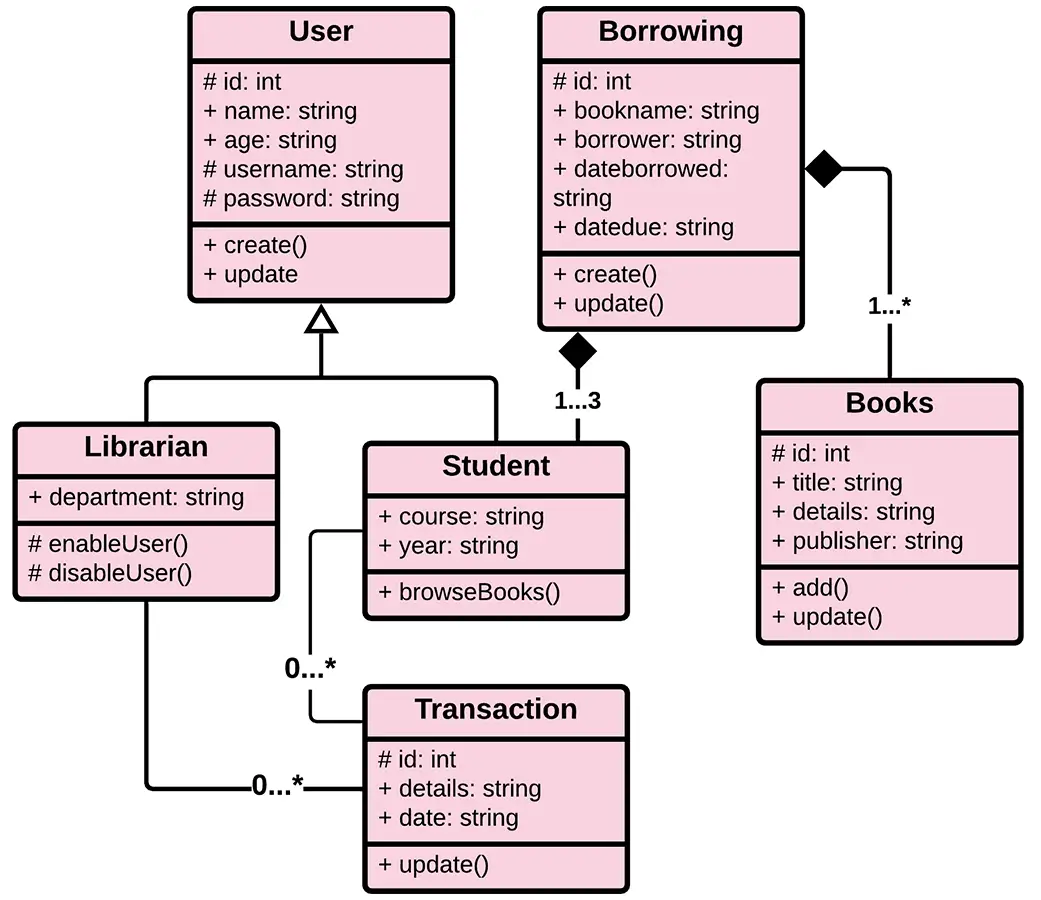
5. Library Management System Sequence Diagram
Library Management System Sequence Diagram is a designed Unified Modeling Language (UML) diagram that shows the sequence of messages or events between objects in the system interactions.
It helps illustrating the sequence of messages that passed between the actors and objects.
Sequence diagrams are also able to explain in details on how Library Management System control the structures between objects.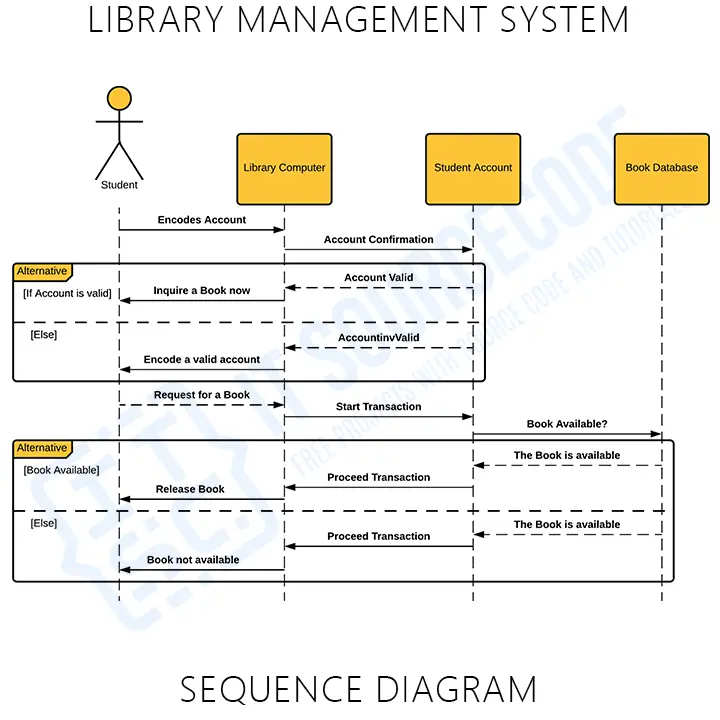
6. Library Management System Activity Diagram
Library Management System Activity Diagram is one of the UML diagrams that will show the behavior of the Library System to its users.
This activity diagram for library management is using symbols just like swimlanes, shapes and arrows, to illustrate the interactions between the user and system.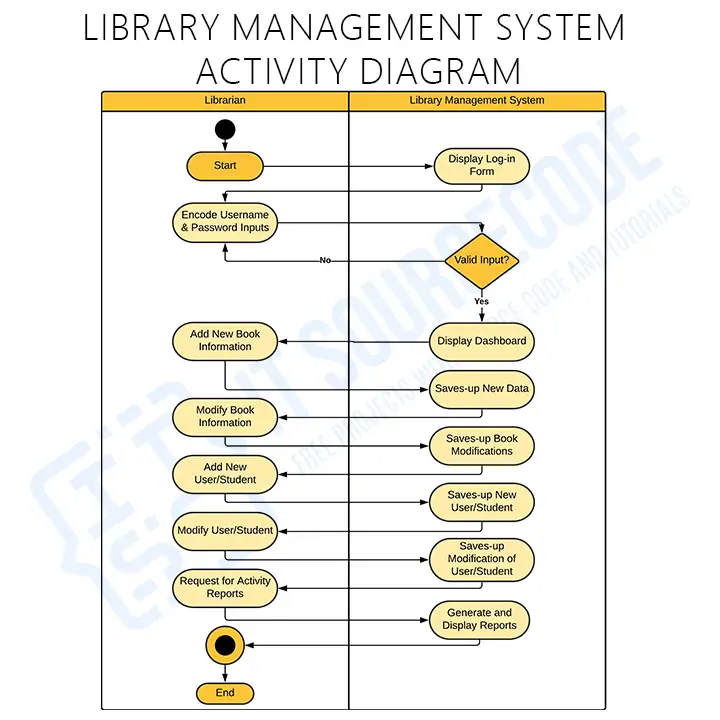
Library Management System Project Documentation PDF
Here is the Library Management System Project Documentation PDF file that you can download by clicking the button below.
It contains the information that you can apply for your project. It can be applied to your project directly or modify its content.
Library Management System Project Proposal and Synopsis
Project Title: Library Management System
Proponents: Name of Students or proponents.
Project Abstract: Performing library management manually is quite difficult, as is maintaining its records in order.
These are the issues that the Library Management System should address and answer.
The Library Management System (LMS) is a program that helps librarians manage a library.
Based on the needs of users, the system could provide a minimal set of functionalities, such as adding and updating members and books. This system can also handle check-in specifications, borrower’s transactions and more.
Problem Statement: The problem is that, in a constantly evolving library, library users expect more efficient way to allocate specific book or keyword(s) within a book.
Solution Statement: A library management system allows users to search for books and other library-related things as well as add, update, and download books.
A library management project is software that organizes and saves books and information electronically to meet the needs of libraries.
Book borrowers and library personnel benefit from the system. It allows them to keep track of all of the books available in the library at all times. The administrator and the student were also allowed to look for the book they needed.
The Library Management System’s major goal is to keep track of information such as books and borrowers’ information.
It manages the data, such as Book borrower’s basic info, as well as the librarians. Then, to provide security for this information, only the admin can have access to the overall database of the system.
Project Scope – the scope of the Library Management System is:
• To assist library personnel in balancing their time and effort while doing their tasks.
• To make the most of resources by boosting their productivity through automation.
• To create a variety of data that is utilized for a variety of reasons.
The information given here reveals the content of Library Management System Project Proposal.
It’s project proposal includes the library management system abstract, statement of the problem and solution, and proponents.
You may have its PDF file by clicking through the button below.
Library Management System Project Report DOC
Here’s the Library Management System Project Report (DOC) document file which is downloadable.
It contains the project report on Library Management System that you can apply for your project.
It can be applied to your project directly or modify its content.
Library Management System Project With Source Codes
Here’s the compilation of Downloadable Library Management System Project source using different programming languages that suite your requirements.
School Library Management System in C# with Source Code
The School Library Management System in C# with Source Code is developed using C# language, this school library system project is a simple automated project aimed at simplifying the manner in which a book is published, saving time and effort.
This School Library Management System in C# windows application is a simple system to use that will increase the library’s performance.
The School Library Management System in C#.net with Source Code is designed to organize information automatically as its input into the system.
These are the following features of the system
- Manages Books
- Manage Borrowers
- Manage Transactions
- Manages Book Categories
- Manages User
- Inventory Reports
- User Logs
- Login and Logout
Online Library Management System in PHP Source Code
The Project was developed using PHP, JavaScript, and CSS. This Website Project contains an admin and user side.
The admin side manages all the management like adding and managing categories, authors, books, issued books, and so on.
The admin has an important role in the management of this online library system.
This Source code can be used by the programmers who want to develop the (LMS) using PHP and MySQL.
For Admin Module Features:
- Admin Dashboard
- Can manage category
- Manage author
- Book Management
- Admin can issue a new book to a student
- Update the details when the student returns the book
- Search student by using their student ID
- View student details
- Change own password
For Students Module Features:
- Register yourself and after registration; they will get student id
- Student can view the dashboard,
- Update personal profile,
- View issued book and book return date-time.
- Change their password, and
- Recover personal password.
Library Management System Java with Source Code
A Library Management System in Java is a software base application implemented in Java platform using MySQL database design.
It is useful for libraries in any schools or similar educational institution to manage and maintain data in database through computerized system.
Using this digital Library Management System Java, users need not search the entire library to find a book; the list of books available is displayed by the application.
The main feature of This Library Management System Java is that all the books available in the library can be borrow by the students.
Also the borrowed books by the students can return in the library.
Additionally, the application effectively maintains the details of users/students to whom books have been issued; it also records the issued date and return date.
Features
- Manage books
- statistics
- Manage students
- Issue books
- Return books
- User login
- User registration
Library Management System in Django with Source Code
The Library Management System Project Report in Django is developed using Python Django, HTML,CSS and JavaScript.
The Library Management System using Django is an advanced management system which provides interface.
A Library Management System in Django runs Django Framework in back-end and HTML, CSS in front-end.
The project contains all the features of a library management like login, interactive UI, issue books, Manage books, Add books to the library. Features Of This Library Management System Project In Django
- Manage Books – In this feature the user can manage all the information of the books including, “add new book” , “update or modify book” and “delete book“.
- Manage Users – In this feature the admin can manage all the information of users including, “add new user” , “update or modify user” and “delete user“.
- Manage Students – In this feature the user can manage the list of the students.
- Login/Logout System – In this feature where the user can login and logout to the system.
Library System in JavaScript with Source Code
The Library System in JavaScript is a system project created using HTML, CSS, and JavaScript.
JavaScript is a scripting language that enables you to create dynamically updating content, control multimedia, animate images, and pretty much everything else, can update and change both HTML and CSS.
Taking about the highlights of this Library System framework, the client can make the rundown of books with their writers and keep them as records.
You simply need to type the book data in the text fields and click the add button to include the data to the record.
Anyway, if you want level up your knowledge in programming especially C/C++ Programming Language, try this new article I’ve made for you Best C Projects with Source Code for Beginners Free Download.
I have here a suggested list of Best JavaScript Projects with Source Code free to download and I’m sure this can help you to improve your skills in JavaScript programming and web development as a whole.
Library Management System in C++ with Source Code
The Library Management System in C++ is written in C++ programming language.
This project is based on a concept of recording owned books, issued books, returned books, students who have borrowed and many more.
Before stepping into the main system a user has to pass through a login system to get access, there are two types of login i.e Student and Librarian Login.
To get access to the Librarian’s account, a password should be provided for the Librarian only. There are many features in this system.
The user can also change the password from the system for their own security.
A Library Management System C++ features is after logging in as a student he/she can only view booklists.
All the system is controlled by the librarian as he/she can view, search, modify, add, delete books, and Issue books. The other main feature contains re-issue books and returns book.
Library Management System In C With Source Code
The Library Management System is develop in C programming language and creating in a console based, this Simple Library Management System Project in C you can perform functions such as add books, return books, issue books, delete record of books issued, view record of books issued, search for books, and more.
File handling has been extensively used in this project for almost all functions. So, this project can definitely guide you to understand C mini projects in a better way.
A Library Management System C Program has six departments – Computer, Electrical, Civil, Electronics, Mechanical and Architecture.
These departments work simultaneously with the operations mentioned above. You can add a book to the Civil section, delete a book from the Electrical section or view issued book details of the Mechanical department.
Library Management System Project In Python and MySQL
The Library Management System Project in Python and MySQL is written in Python programming language, Python is very smooth to research the syntax emphasizes readability and it is able to reduce time-ingesting in developing.
In this article, I will teach you how to create a Library Management System in Python with MySQL Database as backend.
A Library Management System Python is providing all the functionality related to book publication. it tracks all the information and details of the book publication.
We have all develop all type of CRUD (Create, Read, Update and Delete) operation of the book publication. This Library Management System Project in Python Using Tkinter for graphical user interface (GUI).
Library Management System Project PDF Documentation (Chapter 1 – 5)
Chapter I – Introduction
This Library Borrowing System Documentation will help you develop ideas for your own student thesis! But first, let us discuss the contents of Chapter 1. How to write Library Borrowing System Documentation Chapter
- Project Context – The project context gives a strong justification for choosing such a research problem based on his/her capacity and must describe its prevailing issues based on his experience when introducing the research problem.
Finally, in the project context, provide a statement that shows the relationship among the rationale of the study to the proposed research problem. - Purpose and Description – The researcher should discuss what would be the main purpose of developing the proposed system and should give a brief description of the proposed system.
- Objectives – A research objective is a concrete statement that describes what the researcher is trying to achieve.
A well-worded objective will be SMART, i.e. Specific, Measurable, Attainable, Realistic, and Time-bound.
Specific objectives :
– General objectives can be broken into smaller parts to form specific objectives.
– Specific objectives give a clearer vision of what the study is trying to achieve. - Scope and Limitations – The scope explains the nature, coverage and time frame of the study.
The limitation, on the other hand, explains all that is NOT included in your project. - Significance of the Study – This describes the contributions of the study as new knowledge and makes findings more conclusive.
Also, it cites the usefulness of the study to certain groups of people.
Importantly, cite all the persons and groups that would benefit from the study, including the researchers themselves. - Definition of terms – The definition of terms gives definition to the major terms that are relevant to your study. Lastly, the definition can either be connotative or denotative in relation to the study only.
Chapter II – Review of Related Literature
This documentation is about the review of related literature of the Library Management System Project Abstract Chapter 2.
It is about past systems that is critical to the development of your system. Parts of Chapter 2 – Review of Related Literature
- Background of the Study: You will discuss the problem of your target client. Also, you need to write about the history of the client. In this part, you can state the difficulties of using a manual system and the benefits of using your proposed system.
- Related System: You will cite different SYSTEMS that is similar to your study and state significant parts of it that can be applied to your thesis.
Chapter III – Methodology
In this article, we will discuss Chapter 3 which is the methodology you used in your thesis. Chapter 3 is focused on the SDLC you used in completing your system.
Here are the steps on how to write Chapter 3 Methodology.
- Methodology – In this section, you will write a short generalization of the whole Chapter 3 and introduce the methodology you used for the system.
- Systems Development Life Cycle (SDLC) – Next is to explain the SDLC used in this system (with diagram). For this Library Borrowing System example, the researchers chose the Waterfall SDLC.
- Discuss the Steps of the SDLC – You need to discuss the steps used in the chosen SDLC. These steps might differ from various SDLC’s.
- Constraints – Next is to enumerate and explain the possible constraints that you might encounter during the development.
- Architectural Diagram – The Architectural Diagram illustrates the connections between the hardware of your system. Also, write a short description below the diagram.
- System Testing and Implementation – In this part of the documentation, you will describe how your system is implemented and tested by the users.
- System Features – In this part of Chapter 3, you enumerate the functions of your system.
- Recommended Hardware Specifications – Next is to list the hardware needed for your system.
- Recommended Software Specifications – Also, list down the applications needed by the system.
- Recommended Network Specifications – Lastly enumerate the network specifications in order for the system to run.
Chapter IV – Existing System
In Chapter 4, you will discuss the manual system of your target client. You need to determine the objectives, scope and concept of operations of the manual system and create the data flow diagram and activity diagram for that manual system.
Steps in Writing Library Management System Project Abstract and Chapter 4 Documentation and PDF
- General Objectives and Specific Objectives: State the general objective of the manual system and break it down to its specific objectives.
- Scope of the Existing System: Identify the nature and coverage of the manual system
- Concept of the Operation: In this part, you describe the steps on how the manual system operates
- Activity Diagram of the Manual System: This diagram will show the user’s activity when interacting with the manual system
- Data Flow Diagram of the Manual System: This DFD wil show how data traverses into the manual system
Chapter V – Proposed System
Chapter 5 – Proposed System will discuss your proposed system and describe it using different diagrams. This will show that you have achieved your objective from the first chapter.
Here is the guide of the content for Chapter 5 – Proposed System. How to write Chapter 5 – Proposed System
- Proposed Solution
- Scope of the Study
- Concept of Operation
- Use Case Description
- Data Flow Diagram
- Data Dictionary
- Class Diagram
- Entity Relationship Diagram
- Advantages and Disadvantages of the Proposed System
- Technical Feasibility
- Social and Operational Feasibility
- Economic Feasibility
Related Articles:
- School Management System Project Report, Documentations, Coding, Abstract, PDF, Diagram & PPT
- Student Management System Project Report, Documentations, Coding, Abstract, PDF, Diagram & PPT
- College Management System Project Report, Documentations, Coding, Abstract, PDF, Diagram & PPT
- Hotel Management System Project Report – Documentation PDF
- Hospital Management System Project Report, Documentations, Coding, Abstract, PDF, Diagram & PPT
Recommended Articles:
- Library Management System Project in Ruby on Rails with Source Code
- Library Management System Project In Django With Source Code
- Library Management System In ASP NET With Source Code
Inquiries:
So that completes our discussion for Library Management System Project Reports, Abstract, Diagrams, and Thesis Documentation.
You may check the complete illustration of Diagrams, Source Codes, and Documentation by clicking the titles of each explanation.
Now that you have known the parts and definition of creating a Library Management System Project, you can also start creating your own! If you have inquiries or suggestions about this topic, do not hesitate to type in the comments.
Thank you and good day.

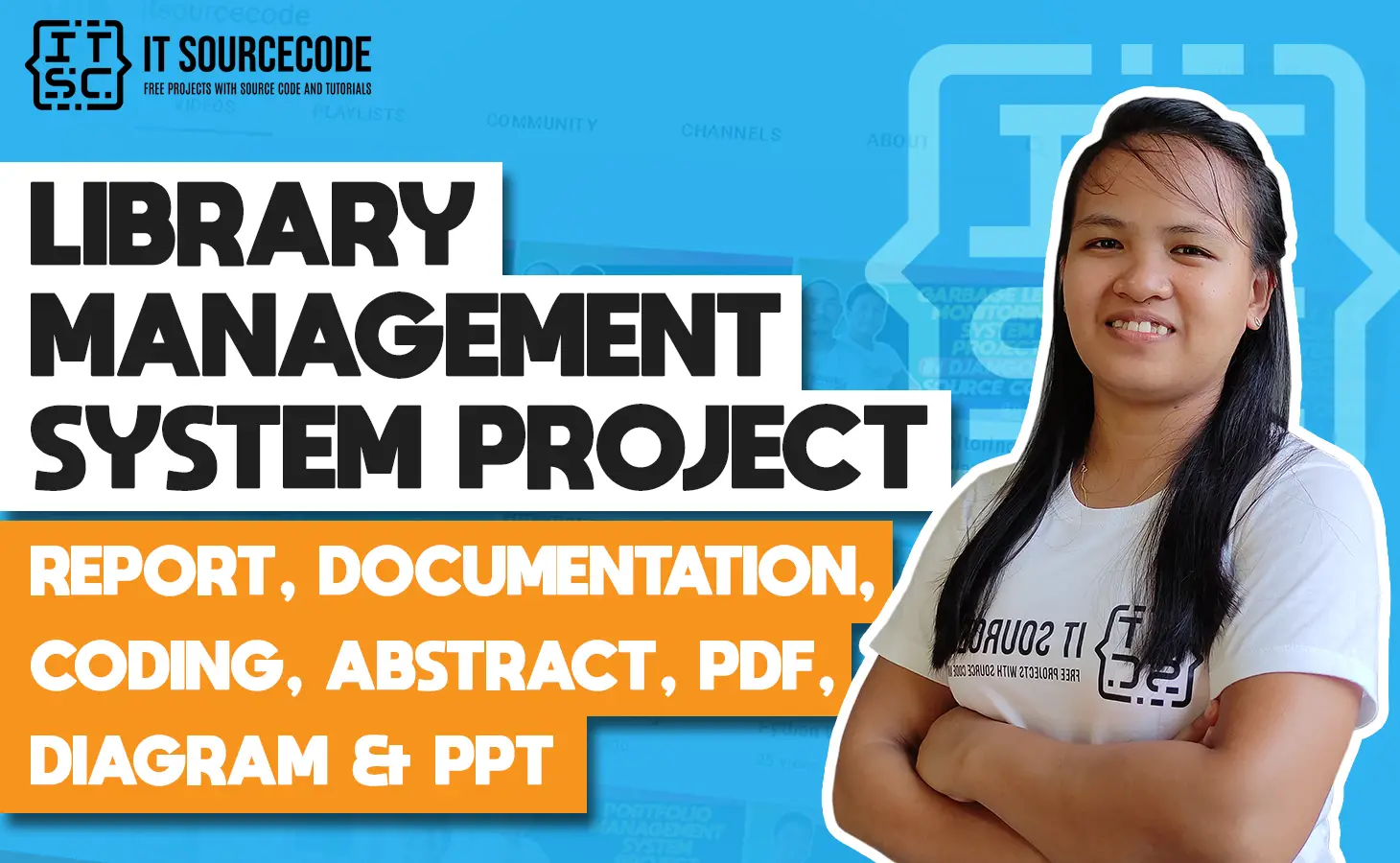
Bhosadi ke download kaise karu ese be
please we nee the code for this work
it’s so amazing work
Just search in our website on what programming language will you used.
C++
Just visit our website in search it.